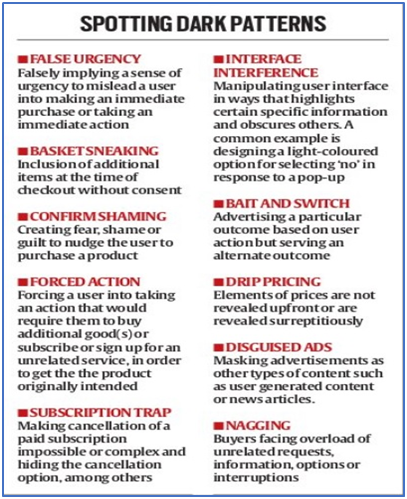Why in news?
- Many people have complained about airlines and online travel websites tricking them into buying things they did not mean to, for example seats, when booking flights.
- A government official even called it a cybercrime.
- Because of these complaints, the Ministry of Civil Aviation has told the low-cost airline IndiGo to fix its website.
- This has, once again, highlighted the menace of dark patterns. A government official even called it a cybercrime.
What’s in today’s article?
- Dark pattern – About, examples, regulation in India
- News Summary
What are Dark Patterns?
- Dark patterns refer to deceptive design techniques used in user interfaces to manipulate or deceive users into taking certain actions or making specific choices online.
- Such patterns are unethical user interface designs that deliberately make Internet experience harder or even exploit the users.
- These patterns exploit cognitive biases and behavioural tendencies to trick or mislead users, often for the benefit of the platform or business implementing them.
- These tricks can include creating a false sense of urgency, making people feel bad for not doing something, forcing them to take certain actions, trapping them into subscriptions, or constantly bothering them.
How do companies use dark patterns?
- Social media companies and Big Tech firms such as Apple, Amazon, Skype, Facebook, LinkedIn, Microsoft, and Google use dark or deceptive patterns to downgrade the user experience to their advantage.
- Amazon
- It came under fire in the EU for its confusing, multi-step cancellation process for the Amazon Prime subscription.
- LinkedIn
- LinkedIn users often receive unsolicited, sponsored messages from influencers.
- Disabling this option is a difficult process with multiple steps that requires users to be familiar with the platform controls.
Regulation of dark patterns in India
- In September 2023, Department of Consumer Affairs has sought public comments on Draft Guidelines for Prevention and Regulation of Dark Patterns.
Key highlights of the draft guidelines
- Objective
- To clearly identify and define tactics as dark patterns so that the Ministry of Consumer Affairs can act against platforms indulging in this under Section 18 of the Consumer Protection Act, 2019.
- Defines dark patterns
- The document defines dark patterns as:
- deceptive design patterns using UI/UX (user interface/user experience) interactions on any platform;
- designed to mislead or trick users to do something they originally did not intend or want to do;
- by subverting or impairing the consumer autonomy, decision making or choice;
- amounting to misleading advertisement or unfair trade practice or violation of consumer rights.
- For instance, false urgency is a dark pattern under which the online seller makes false claims of limited stock (“hurry, only two items left!”).
- This misleads the user/buyer into making an immediate purchase or act immediately.
- The draft guidelines propose prohibitions against engaging in dark patterns.
- Applicability
- The draft guidelines, once notified, shall apply to all platforms systematically offering goods or services in India, advertisers and sellers.
- Specifies 10 types of dark patterns
News Summary: Dark pattern sales deemed ‘cybercrime’
- An analysis of airline websites, apps and online portals by a leading media house in India showed that dark patterns were widely prevalent.
Case Study: Use of dark pattern by Indigo airlines
- IndiGo’s website deploys a technique known as false urgency.
- Under this, the airline gives consumers booking an air ticket the impression that they have to pay an extra fee of ₹99 to ₹1,500 to buy a seat to complete the purchase, as all free seats are shown as unavailable.
- Sometimes, there will be four or five free seats available but they are relegated to the bottom of the aircraft cabin and can be harder to locate and navigate to on the webpage.
- The passengers can hit the skip button at the end of the seat selection page.
- However,they are not informed in a transparent manner that free seats will be auto-assigned to them if they do not wish to pay the extra sum.
- Indigo has also been found indulged in a practice known as interface interference.
- Interface interference is a situation where the website design highlights certain specific information and deliberately obscures other information.
- On IndiGo’s mobile application, the option to skip is placed in the top right corner and displayed in a tiny font.










